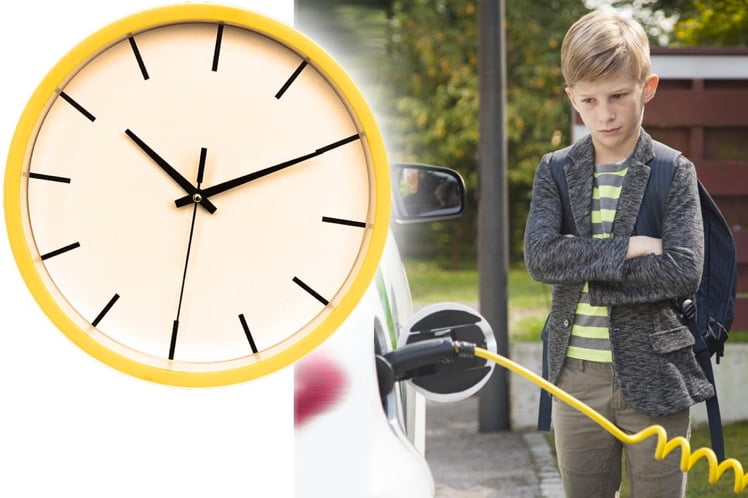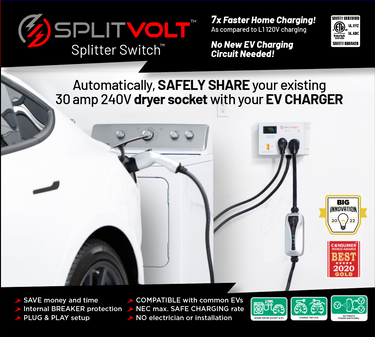
How to Charge Your EV Faster at Home and Save Money
How to Charge Your EV Faster at Home and Save Money
Faster Home EV Charging Explained
There are some simple ways to charge your EV faster at home. Are you new to the world of electric vehicles—EVs for short? If yes, you will be a little confused about how to get your EV charged fast at your own home. This article sets out how to easily optimize home charging. It also explains some of the key terms the EV-world uses when discussing these issues. Despite the growing range of public and workplace charging stations, 80% of EV charging takes place at home, according to the US Department of Energy. Hence, that’s where we will place our focus today. To make this explanation more practical, we’ll look at how to charge three popular EVs: the Nissan Leaf, the Chevy Bolt, and the Tesla range of EVs.
More than 80% of EV charging takes place at home.
U.S. Department of Energy
EV Charging Levels Explained
There are a number of EV charging methods, each with its advantages and disadvantages: Level 1, Level 2, and Level 3. Level 3 charging, is the fastest of the three, however, it uses a dedicated charging device hardwired to your household electricity. This makes the purchase and installation of the system expensive – typically thousands of dollars! Instead, here, we’ll take an in depth look at two of the most common and low-cost methods of charging at home: Level 1 and Level 2 charging. We will focus on how to charge your EV faster at home.
Level 1 Charging
Level 1 is the simplest form of charging. Every EV manufacturer provides a cable that can connect the charging inlet on your EV to the 120v power socket. This standard socket is found in every home in the United States. Most likely, you have one in your garage and can use it to charge your car overnight! So, no need to spend another dollar on charging equipment or electricians. You can get up and charging right away!
That’s pretty much the total of the good news about Level 1 charging! The not-so-good news is that the charging speed of the 120v socket is rather…slow. One of the most significant EV developments in recent years is a welcome increase in battery capacity. This has resulted in greatly increased driving range. Not surprisingly, these bigger batteries do take longer to charge. This is the case especially from a standard 120v power outlet. The new Chevy Bolt, for example, takes up to 40 hours to charge using this method!
The charging rate for a given method or charging device is often expressed in ‘miles of charge per hour’—in other words: how many miles could a given EV travel after it has charged for one hour?
Miles of Charge Per Hour
What is ‘Miles of Charge Per Hour'?
The charging rate for a given method or charging device is often expressed in ‘miles of charge per hour’. In other words: how many miles can EV travel after it has charged for one hour? Level 1 charging typically charges a vehicle at 3-5 miles per hour. Say your EV battery has a range of 200 miles, and recharges at 5 miles per hour. It will—indeed—take 40 hours to fully recharge when completely drained.
So, in summary, Level 1 charging will get you up and running right away. Its cheap, because you use a power socket you probably already have in your home garage. However, modern EV’s have long-range capability because of their large battery capacity. This means that the Level 1 charging process is frustratingly slow. Clearly there is a better way to charge your EV faster at home!

Level 2 Charging – Charge your EV Faster at Home
While Level 1 charging uses the standard 120v electricity supply, Level 2 charging uses 240v. Fortunately, most homes in US already have a 240V supply in their garage. These 240v power sockets are typically used to run electric clothes dryers. On occasion they are also used for other high-power appliances, such as air-conditioners, electric-ranges or welders. If you have one already installed, great- because they can enable you to charge your EV faster at home.
All three of the EV’s discussed here—the Chevy Bolt, Nissan Leaf and the Tesla range—are available with manufacturer-provided, low-cost options to enable EV charging directly from this type of 240v socket. The process is almost as easy as powering with the 120v system. Simply plug in the correct manufacturer-provided charging cable via a socket adapter. A socket adapter is often required to convert to the correct physical format for your specific 240v outlet type.
While the voltage doubles from 120v to 240v, the rate of ‘miles of charge per hour’ does significantly better, cutting charge time to one quarter or less for the Chevy Bolt!
Speed Up Your Charging Time
While the voltage doubles from 120v to 240v, the rate of ‘miles of charge per hour’ does significantly better. This will cut charge time to one quarter or less for the Chevy Bolt! Using the Level 2 method, the charge time on the Chevy Bolt reduces from 40 hours, down to just 5-10 hours. The exact charge speed depends on the capacity of your 240v circuit. This means that your EV is now charging at between 10 and 20 miles per hour! A great way to charge your EV faster at home.
From a practical perspective, most days you’re unlikely to charge your EV from completely empty. This 5-to-10-hour charge time is very convenient. This is because it ensures your car will be at full charge each morning by simply plugging it in overnight.
Low-Cost Access to Level 2 Charging
Level 2 charging is really the way to go for charging your modern, high-capacity EV at home. It gets the job done in a fraction of the time that Level 1 EV charging requires. And there is with little more cost outlay. Enabling Level 2 charging varies slightly depending on the car manufacturer, as outlined below.
Telsa Charger Adapters
Tesla supply all of their new vehicles with a charging unit known as the ‘Gen 2 Mobile Connector’ (MC). The MC supports both Level 1 charging at 120v and Level 2 charging at 240v. Tesla have a range of adapters to suit a variety of 240v sockets so, most likely the existing socket you have in your garage. The MC supports Level 2 charging at up to 32 amps depending on the adapter type, with the amperage determining the actual charge speed. Adapters for the various 240v socket types are available directly from Tesla for around $35 each. The key factor keeping costs low with this method of Level 2 of charging, is that there’s no need to call an electrician!
Summary
Sure, you can charge your new electric vehicle by plugging into the standard 120v socket in your garage. The problem is that this Level 1 type charging will probably prove impractical and will frustrate you. This is because it takes too long to charge and diminishes your experience as an EV owner. Level 2 charging is available at a relatively low cost for most EV owners. Often using a pre-existing 240v socket which (most likely) is already in your garage. The methods of making this work vary a little by manufacturer, but these low-cost, low-hassle options are available. For most people the simplicity, economy, and speed of Level 2 charging, is a great way to get your EV up and running! The key to charging your EV faster at home and at lower cost is checking which 240v socket is already installed in your own garage.






